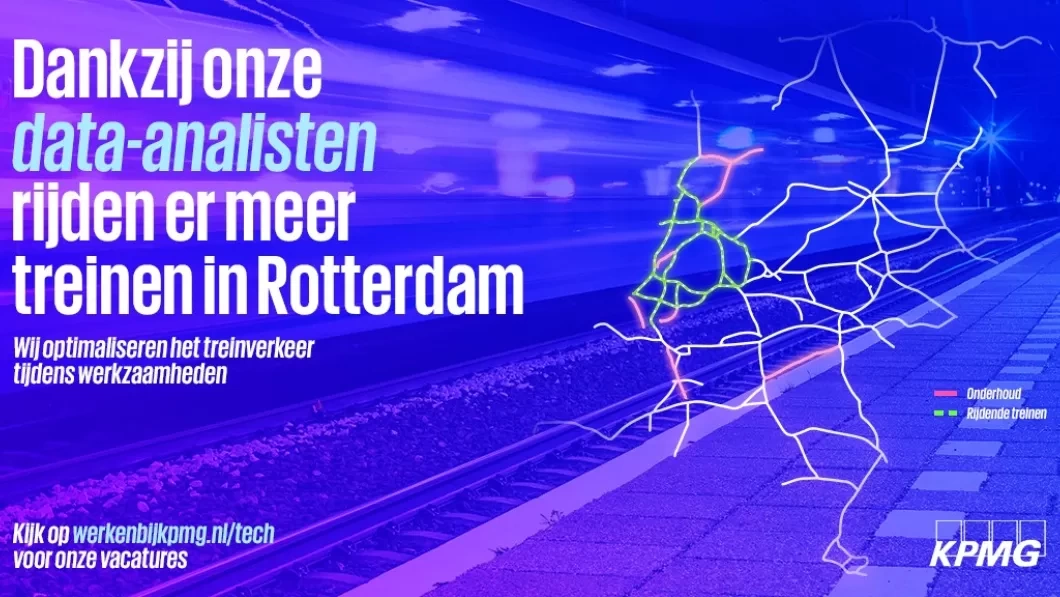Working in Data & Analytics: an opportunity to add real value for the users of ProRail
Working in Data & Analytics at KPMG. What does it entail? David Dikmann-Falk works as a Manager in the Data & Analytics team of the Technology Department and takes us backstage to see what it’s really like to work in the Data & Analytics team. One thing’s for sure: Thanks to David and his team, ProRail can plan maintenance more effectively and reduce inconvenience for passengers.
David has been working in KPMG’s Data & Analytics team since 2014. “What’s great about working here is the variety of projects and clients, which enables you to grow fast in your field.” In the Data & Analytics team you work on a wide range of assignments, sometimes for small, and sometimes for bigger clients. Recently for instance, David worked on a case for ProRail. And he’s keen to tell us about it.
The ProRail challenge
ProRail services over 7,000 kilometers of railway infrastructure in the Netherlands. This also means planning over 1,000 activities per year, and coordinating these in cooperation with various parties. Planning at this level is of course not something to be taken lightly. You need to consider the inconvenience for passengers and goods, the fluctuating costs of subcontractors, the cost of detours, and a multitude of other arrangements with stakeholders like transporters and municipalities. Large events must also be taken into account, to ensure that they don't suffer any inconvenience due to less or no train traffic. It is easy to see that manual planning is labor intensive, and that finding the optimal schedule is simply impossible without smart IT solutions.
To tackle these challenges, ProRail had a bespoke algorithm developed and implemented to optimize planning.
During the project for ProRail we worked closely with ProRail experts and with a specialized consulting firm. A truly multi-functional team with lots of smart people in it.
David Dikmann-Falk, Manager Data & Analytics
What did David and his team do?
We developed the TVP planner for ProRail. TVP stands for: ‘treinvrije periode’ (train-free period). The TVP planner helps to work out an optimal schedule under conditions that the user can select from, including for example a schedule that causes the least inconvenience for passengers. To do this, we worked together on complex topics.
Identifying and extracting appropriate data from the primary source systems was one of the first tasks in the project. We analyzed a lot of ProRail source systems, as well as external data. A thorough analysis of the available data also impacted the ultimate functionality of the application, since we had to work out what could be done with the available data. The team then wrote a data-transformation logic to link up data sources that had never been connected with each other in this way before. Together with a specialized consulting firm, the planning algorithm was implemented and a user-friendly interface was developed for the application.
The TVP planner application was implemented entirely on ProRail’s Azure Cloud platform. For this, we used container technology in combination with modern tools on the Azure platform. By linking it up to the ProRail network, the TVP planner application can be used like any other internal application, which is great for end users.
The various components of the application were developed in an iterative, agile process with short communication lines which ensured collaboration between all the parties involved.
The result
How did ProRail benefit from this? The TVP planner keeps inconvenience for passengers down to a minimum. But the application can also be used to create an ad-hoc schedule. This means that the schedule can be adjusted faster, and the planning process becomes more data-driven. Other advantages are for example the use of ‘what if’ scenarios to plan schedules for the next 5 years, and support during joint planning sessions based on complete planning scenarios.
“ProRail works on connecting, improving, and making railways more sustainable. But railways also keep getting fuller. To enable more trains to run and to adapt the railways accordingly, works will have to be done more frequently. By using various datasets and algorithms, scenarios can be identified in the TVP planner, and works and the impact thereof can be made generally understandable for everyone involved.” - Maarten de Jonge, Product Owner, TVP planner
Let’s meet!
Would you like to work on cases like this? At KPMG you will work in an open, informal culture. You will quickly gain many responsibilities as well as the freedom to grow. Both professionally and personally. Want to find out what possibilities there are for you to work in our Data & Analytics team?




